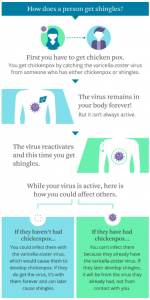Written by Home Doctor Brisbane team
What is Shingles?
Shingles (or herpes zoster) is a condition caused by the chickenpox (varicella-zoster) virus and can only occur in people who have previously had chickenpox.
When a person recovers from chickenpox, the virus does not completely disappear from the body but stays dormant in the nerves close to the spine.
It’s estimated that around one in four people will have at least one episode of shingles during their life.
Is Shingles contagious?
Shingles cannot be passed from one person to another, however the virus that causes shingles, the varicella zoster virus, can spread from a person with active shingles to cause chickenpox in someone who has never had chickenpox or received the chickenpox vaccine.
A person with active shingles can spread the virus when the rash is in the blister-phase. Direct contact with fluid from the rash blisters causes the virus to spread from person to person.
A person is not infectious before the blisters appear and once the rash has developed crusts, the person is no longer infectious.
Who can get Shingles?
Shingles is uncommon before the age of 12 years with most cases occurring in people over the age of 40.
Exactly what triggers the chickenpox virus to become active again and cause shingles is not clearly understood. It is thought that some decrease in the strength of your immune system (even if only temporary, such as experienced when you have a cold) is needed to allow activation of the virus.
Once you have had chickenpox, it is very rare for you to get chickenpox again, although it is possible for you to develop Shingles at some point in the future.
What are the symptoms?
The main symptom of shingles is pain, followed by a rash that develops into itchy blisters, similar in appearance to chickenpox.
New blisters may appear for up to a week, but a few days after becoming apparent, they turn yellowish in colour, flatten and dry out.
Scabs then form where the blisters were, which may leave some slight scarring.
The pain may be a constant, dull or burning sensation and its intensity can vary from mild to severe. Those with Shingles may have sharp stabbing pains from time to time, and the affected area of skin will usually be tender.
In some cases, shingles may cause some early symptoms that develop a few days before the painful rash first appears. These early symptoms can include:
- A headache
- Burning, tingling, numbness or itchiness of the skin in the affected area
- A general feeling of being unwell
- A high temperature (fever).
An episode of Shingles typically lasts around two to four weeks. It usually affects a specific area on one side of the body and doesn’t cross over the midline of the body (an imaginary line running from between your eyes down past the belly button).
Any part of your body can be affected, including your face and eyes, but the chest and abdomen (tummy) are the most common areas.
Source: Healthline
When to seek medical advice
Shingles isn’t usually serious, however, you need to see your GP as soon as possible if you recognise the symptoms, even after hours. They’ll usually be able to diagnose shingles based on your symptoms and the appearance of the rash.
Early treatment may help to reduce the severity of your symptoms and the risk of developing complications.
Referral to hospital
It’s uncommon for someone with Shingles to be referred to hospital, but your GP may consider seeking specialist advice if:
- They suspect a complication of shingles, such as meningitis or encephalitis
- Shingles is affecting one of your eyes – there’s a risk you could develop permanent vision problems if the condition isn’t treated quickly
- A diagnosis isn’t certain
- You have an unusually persistent case of shingles that’s not responding to treatment
- You’ve been diagnosed with the condition more than twice
- You’re pregnant
- You have a weakened immune system – particularly in severe cases or cases affecting children.
Treatment
Shingles can be treated with antiviral drugs, however treatment should be started within 72 hours of the rash appearing for the most benefit. If you think you have Shingles, seek prompt medical attention.
Most treatment is aimed at reducing the initial pain and rash. Other drugs that may be used to help ease symptoms include pain killers and topical ointments.
Shingles to the upper half of the face may cause serious damage to the eye and medical assessment should be sought immediately.
It is important that the affected skin site be kept clean to avoid secondary bacterial infections. Avoid pricking or scratching the blisters.
The Shingles vaccine
The Shingles vaccine is different from the chickenpox vaccine. It reduces the risk of getting Shingles and the widespread nerve pain associated with it.
From November 2016, a single dose of zoster vaccine is funded for all adults aged 70 years of age under the National Immunisation Program. There is a 5 year catch-up program for people aged 71 to 79 years until 31 October 2021.
To receive the funded vaccine, visit your local doctor or vaccination provider. Although the vaccine is provided at no cost, a consultation fee may apply.






